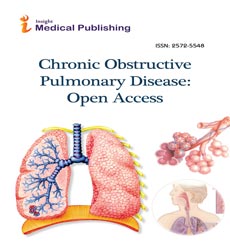Non-Invasive Ventilation in Acute, Post-Acute and Stable COPD
Satish Kumar Mishra
Department of Cardiothoracic Anesthesia, Military Hospital (CTC), Pune, India
Published Date: 2022-01-31Satish Kumar Mishra
Department of Cardiothoracic Anesthesia, Military Hospital (CTC), Pune, India
Received date: 2022-01-02 | Accepted date: 2022-01-11 | Published date: 2022-01-31
Abstract
Non-invasive ventilation (NIV) has revolutionized the management of acute respiratory failure in chronic obstructive pulmonary disease (COPD), and is targeted at reducing respiratory system load and work of breathing. Compared with invasive mechanical ventilation (IMV), NIV is associated with a shorter length of ventilatory assistance, reduced length of ICU and hospital stay, a reduced rate of ventilator-associated pneumonia and a reduction in intubation rates. NIV also improves in-hospital survival. In the longer term, compared with IMV, NIV is associated with a reduction in the frequency and duration of exacerbations, and a lower requirement for long-term oxygen therapy (LTOT). The use of NIV in acute exacerbations of COPD (AECOPD) has escalated since the 1990s as the evidence base for its efficacy has increased with a corresponding reduction in the need for IMV. However, there is rising mortality among patients who failed NIV and required IMV, which may reflect the use of NIV in patients with increasingly severe respiratory failure. Nonetheless, effective NIV can be delivered to those patients with severe acidosis or hypercapnic encephalopathy, and in elderly patients. The evidence for home mechanical ventilation (HMV) to treat patients with stable COPD had been lacking until recently. Higher levels of pressure support targeted at controlling nocturnal hypoventilation has led to a reduction in all-cause mortality. Home oxygen therapy (HOT) and HMV delivered immediately following AECOPD failed to demonstrate an improvement in admission-free survival. In patients with persistent hypercapnic respiratory failure in the recovery phase 2–4 weeks following a life-threatening exacerbation, NIV targeted at reduction in nocturnal carbon dioxide levels in combination with home oxygen therapy (HOT-HMV) was effective in reducing time to readmission or death.
Open Access Journals
- Aquaculture & Veterinary Science
- Chemistry & Chemical Sciences
- Clinical Sciences
- Engineering
- General Science
- Genetics & Molecular Biology
- Health Care & Nursing
- Immunology & Microbiology
- Materials Science
- Mathematics & Physics
- Medical Sciences
- Neurology & Psychiatry
- Oncology & Cancer Science
- Pharmaceutical Sciences
